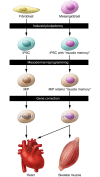Memory or amnesia: the dilemma of stem cell therapy in muscular dystrophies
- PMID: 26571391
- PMCID: PMC4665769
- DOI: 10.1172/JCI85002
Memory or amnesia: the dilemma of stem cell therapy in muscular dystrophies
Abstract
Muscular dystrophies are monogenetic diseases that are often characterized by the degeneration of both cardiac and skeletal muscle. Gene therapy to correct the mutated gene has shown promise in both animal models and clinical trials; however, current gene delivery strategies are limited to the introduction of the corrected gene into only one tissue. Strategies to target multiple striated muscle types would provide a much-needed improvement for the treatment of muscular dystrophies. In this issue of the JCI, Quattrocelli and colleagues demonstrate that induced pluripotent stem cells (iPSCs) with a myogenic propensity are able to engraft into both cardiac and skeletal muscles. The authors also identified a novel pool of mesodermal iPSC-derived progenitors (MiPs). Moreover, the authors show that these MiPs are amenable to gene correction and can restore function in murine dystrophic models. Together, the results of this study provide an important advance in improving gene delivery to treat patients with muscular dystrophy.
Figures

Comment on
-
Mesodermal iPSC-derived progenitor cells functionally regenerate cardiac and skeletal muscle.J Clin Invest. 2015 Dec;125(12):4463-82. doi: 10.1172/JCI82735. Epub 2015 Nov 16. J Clin Invest. 2015. PMID: 26571398 Free PMC article.
References
-
- Kimbrel EA, Lanza R. Current status of pluripotent stem cells: moving the first therapies to the clinic. Nat Rev Drug Discov. 2015;14(10):681–692. - PubMed

